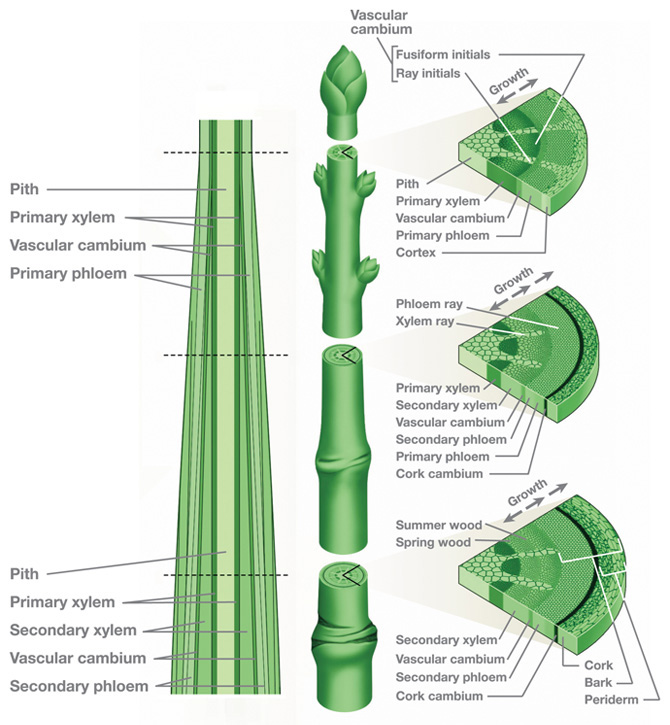
 |
|
Hydroponics - Indoor HorticultureHydroponics - Indoor Horticulture represents an educational, in-depth,
up-to-date, indoor horticultural growers guide that covers all principles
of indoor Hydroponics - Indoor Horticulture examines, explores, dissects and
presents a fully comprehensive step by step growers guide, relating
to all and every aspect of indoor hydroponic horticulture, with complete
chapters on plant biology, propagation, hydroponic systems, nutrients,
oxygen, carbon dioxide enrichment, pH, biological pest control, fungi/disease,
cuttings/clones, pruning/training, breeding, harvesting, equipment,
grow rooms, a full history of hydroponics, and more. |
| (Below follows a one page sample taken from the book) |

| Example of a Cross Section of a Stem |
StemsStems are an integral part of the health and overall happiness of the plant. The stems act as a reflector indicating signs of stress and strength. Stems, due to their nature, are the supply pipelines for the roots and leaves.The stem is the main supporting structure of a plant and serves to transport and to store water and food. The vascular system in the stem is mainly made up of xylem which are upward conducting, and phloem which are downward conducting tissues, usually in vascular bundles arranged concentrically on either side of the cambium with the xylem inside and the phloem on the outside. The vascular bundle is a strand of conducting tissue extending lengthwise through the stems and roots of C3 plants. The vascular bundle consists of xylem which conducts water and dissolved mineral substances from the roots to the leaves, and phloem which conducts dissolved foods, especially sugars, from the leaves to the storage tissues of the stem and rootball. The structure of vascular bundles varies among the different plant groups. The pith is a central core of spongy tissue and is surrounded by strands or bundles of conducting xylem and phloem. The cambium, which is an area of actively dividing cells, lies just below the bark. Lateral buds and leaves grow out of the stem at intervals called nodes; the intervals on the stem between the nodes are called internodes. The pith is the core of the stem of most plants. Pith is composed of large, loosely packed food storage cells. As the stem grows older, the pith usually dries out, and in some plants it disintegrates and the stem becomes hollow. Plants contain two separate transport systems running side by side. These allow substances, such as water, minerals and sugars, to be transported to different parts of the plant. They also provide plants with support, helped by the distended cells. |
Xylem is a continuous system of tubes running from the roots to the leaves. It consists of empty, dead cells with thickened sidewalls ... well this is the conventional view and for decades, researchers have seen the xylem as a column of dead tissue, like a worn pipe, that sits inside plant stems passively supplying water to thirsty leaves. However, in a recently published paper, a team of plant biologists reported that gels in key xylem membranes constantly shrink and swell. With this motion, the xylem actually adjusts the flow of mineral-rich water coursing towards leaves. The xylem is a part of the vascular system that transports water and dissolved minerals from the roots to the rest of the plant and may also provide mechanical support. Xylem consists of specialized water conducting tissues made up mostly of narrow, elongated and hollow cells. The phloem is composed of various specialised cells called sieve tubes, companion cells, phloem fibres and phloem parenchyma cells. Sieve tubes are columns of sieve tube cells which have perforated areas in their walls and provide the main channels in which food elements travel. Phloem fibres are long, flexible cells that make up the soft fibres used commercially e.g., flax and hemp. The phloem may also be called bast tissues in plants that conduct foods made in the leaves to all other parts of the plant. The cambium is a layer of actively dividing cells between xylem which are fluid conducting and phloem which are food conducting tissues and are responsible for the secondary growth of stems and roots, resulting in an increase in thickness. The cortex is a tissue of unspecialised cells lying between the epidermis (surface cells) and the vascular or conducting tissues of stems and roots. Cortical cells may contain stored food or other substances such as resins, latex, essential oils, and tannins. The epidermis is the outermost layer of cells covering the stem, root, leaf, flower, fruit, and seed parts of a plant. The epidermis and its waxy cuticle provide a protective barrier against injury, water loss, and infection. Various modified epidermal cells regulate transpiration, increase water absorption, and secrete substances. |
|
 |